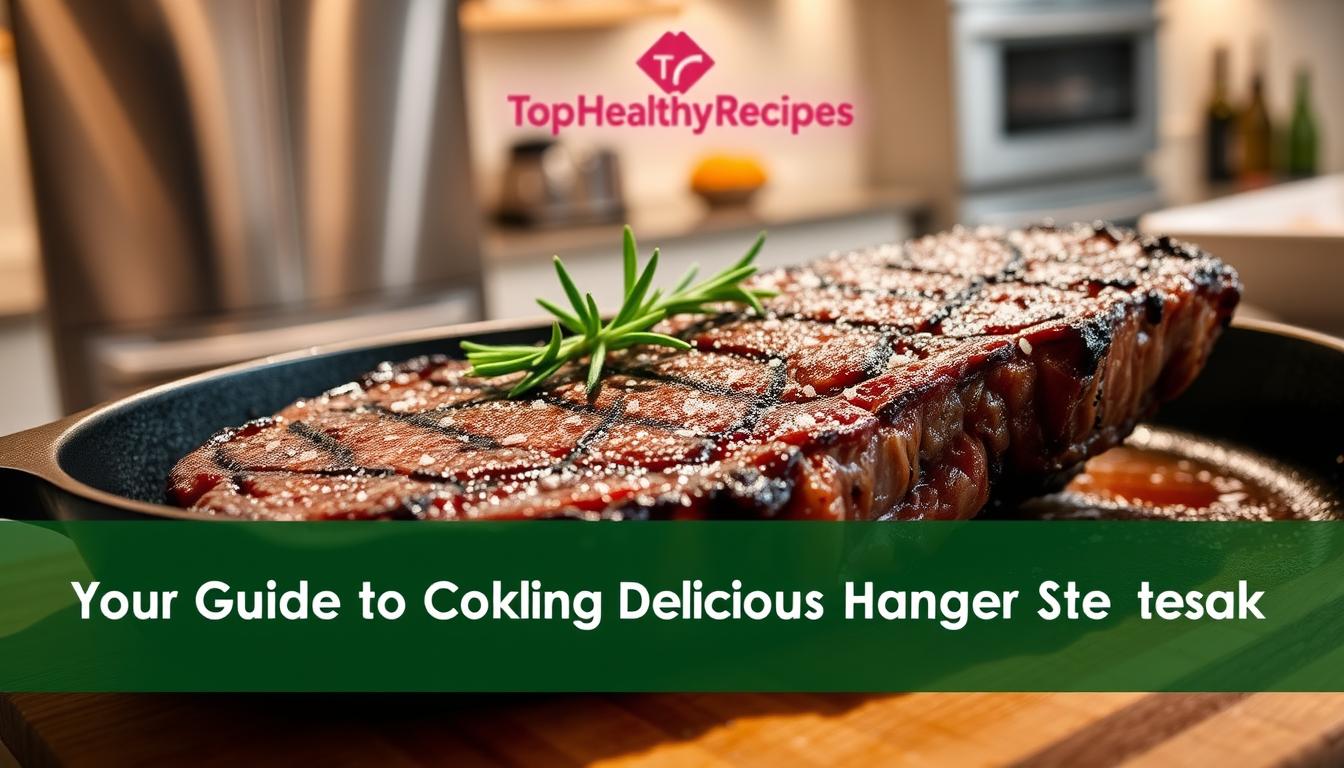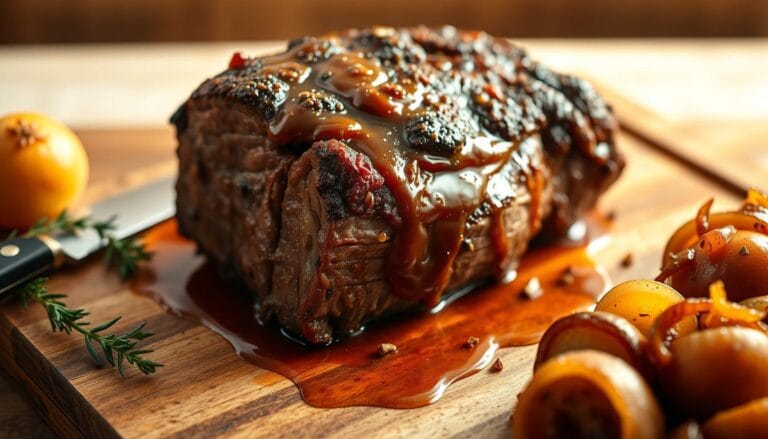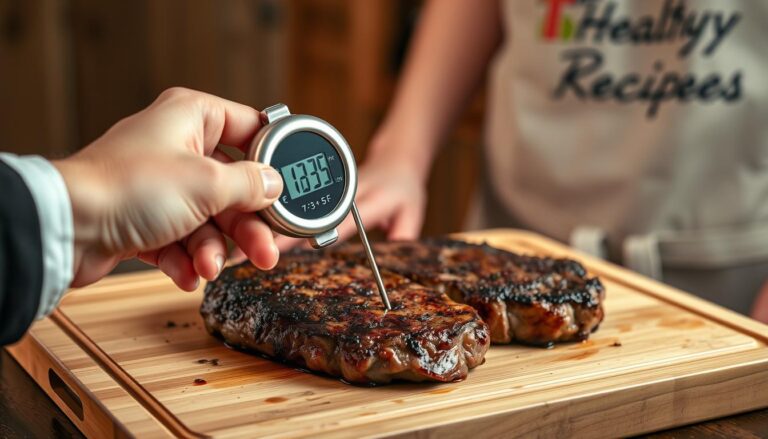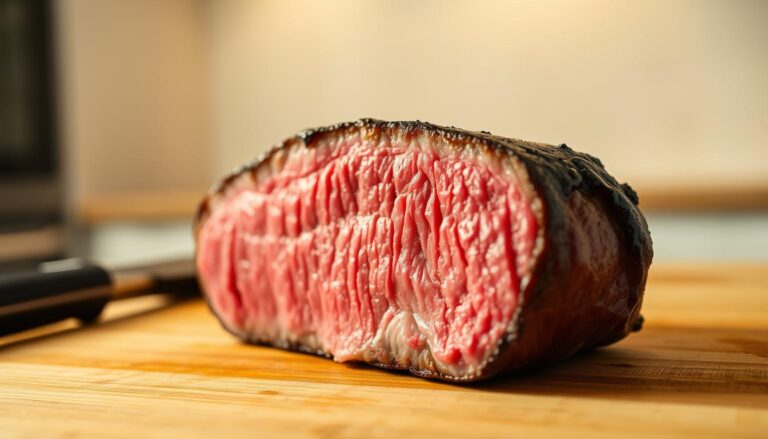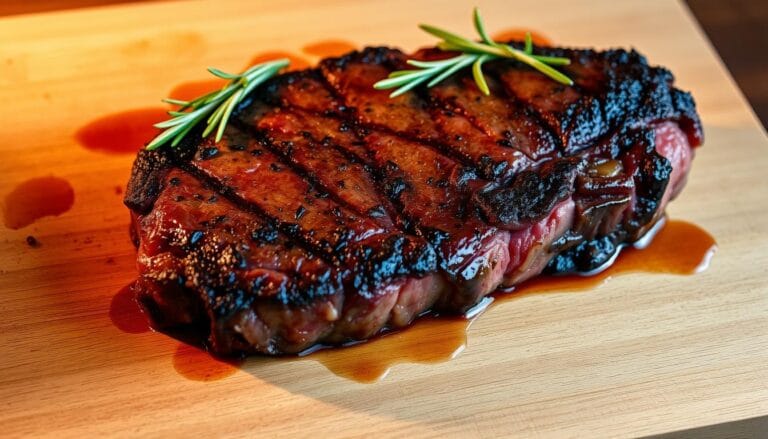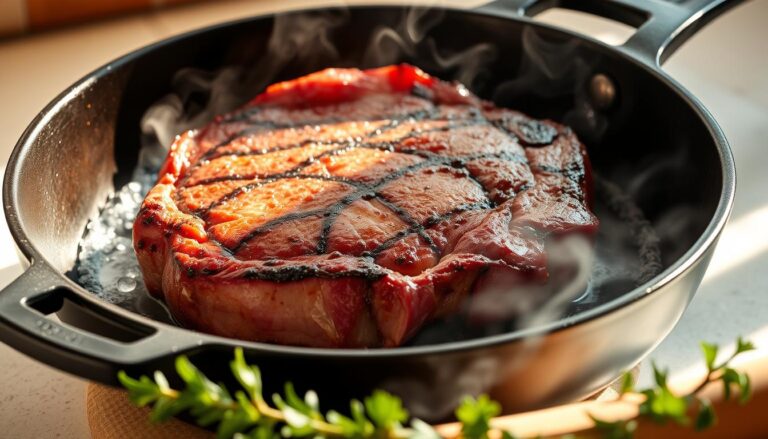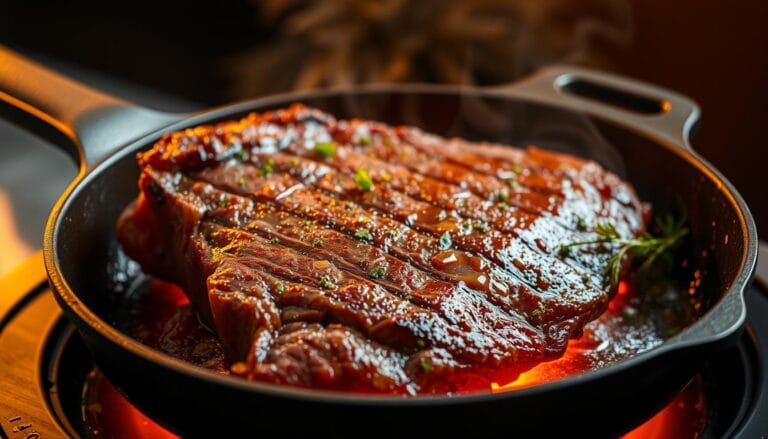How to Cook Hanger Steak for Maximum Flavor and Tender Results
Table of Contents
How to Cook Hanger Steak for Maximum Flavor and Tender Results
Imagine enjoying a tender, juicy hanger steak, cooked just right. Its rich flavors and satisfying texture make it a true culinary delight. It’s sure to impress anyone.
You don’t need to be a pro chef to cook a great hanger steak. With the right tips, you can make a mouth-watering hanger steak that’s as good as your favorite restaurant’s.
This guide will show you how to do it. From picking the right cut to serving a dish that will wow everyone, we’ve got you covered.
Key Takeaways
- Learn the best practices for selecting a high-quality hanger steak
- Discover the most effective cooking methods for achieving tender, juicy results
- Understand the importance of proper temperature control
- Explore various serving suggestions to elevate your dining experience
- Master the techniques used by professional chefs to prepare this flavorful cut of meat
What is Hanger Steak?
Hanger steak is a cut of meat that’s becoming more popular. It’s tender and has a rich beefy taste. This steak comes from the cow’s diaphragm, between the rib and loin. Butchers used to keep it for themselves, calling it “butcher’s steak.”
Understanding the Cut of Meat
Hanger steak has a coarse texture and a strong flavor. It’s a small cut, weighing 1-2 pounds. Its unique location gives it a rich taste, making it a favorite among steak fans.
Key characteristics of hanger steak include:
- A coarse texture that becomes tender with proper cooking
- A robust, beefy flavor with mineral notes
- A relatively small size, making it perfect for individual servings
Flavor Profile of Hanger Steak
The flavor of hanger steak is rich and beefy, with a hint of sweetness. Its unique location and minimal handling make it tender and flavorful. When cooked right, it has a mineral-forward taste that’s both complex and satisfying.
Cooking Techniques Best Suited for Hanger Steak
Cooking hanger steak needs methods that highlight its natural qualities. High-heat methods like grilling and pan-searing are best. They create a nice crust on the outside while keeping the inside tender. These methods bring out the steak’s natural flavors and textures, making it a true culinary delight.
Some recommended cooking techniques include:
- Grilling over high heat to achieve a nice char
- Pan-searing with a hot skillet to create a flavorful crust
- Cooking to the right doneness, typically medium-rare to medium
Why Choose Hanger Steak?
Hanger steak is a great choice if you want a steak that’s tasty, tender, and affordable. It has a unique mix of qualities that make it appealing to both home cooks and steak lovers. Its rich flavor, tender texture, and good price make it stand out.
The Benefits of Cooking Hanger Steak
Hanger steak is loved for its intense beef flavor and tender texture. It’s versatile in recipes, from simple grilling to complex dishes. This makes it a great choice for different cooking styles.
Nutritional Value: What You’re Getting
Hanger steak is not just tasty; it’s also nutritious. It’s full of protein, iron, zinc, and B vitamins. Here’s what you get in a serving (about 3 ounces or 85g):
| Nutrient | Amount | % Daily Value |
|---|---|---|
| Protein | 22g | 44% |
| Iron | 3mg | 15% |
| Zinc | 4mg | 25% |
| Vitamin B12 | 2mcg | 33% |
Hanger steak is also lean, making it a good choice for those watching their diet. When cooked right, it’s a meal that’s both satisfying and delicious.
In short, hanger steak is a cut that’s worth its price. It’s not just tasty; it’s also full of nutrients. Whether you’re a pro chef or a home cook, adding hanger steak to your recipes can take your cooking to the next level.
How to Select the Perfect Hanger Steak
Finding the perfect hanger steak starts with selecting the best cut. At the butcher or grocery store, knowing what to look for is key. It greatly affects your meal’s quality.
First, look for a deep red color with little browning. The best hanger steak has a good marbling pattern. This means the meat has fat inside that makes it tender and flavorful.
Tips for Choosing Fresh Hanger Steak
Choosing a hanger steak means checking its freshness and quality. Here are some tips:
- Check the color: It should be a deep red.
- Look for marbling: A good marbling pattern indicates tenderness and flavor.
- Assess the texture: The meat should feel firm to the touch.
- Check the trimming: Ensure the central membrane is removed or can be easily removed.
What to Look for in Quality Meat
Understanding labeling terms helps you make a better choice. Terms like “grass-fed” versus “grain-finished” affect flavor and nutrition. Talking to your butcher can give you insights into the meat’s origin and quality.
When deciding on portion sizes, think about how many people you’re serving and their appetites. A good rule is to plan for 6-8 ounces of hanger steak per person.
Preparing Hanger Steak for Cooking
Getting your hanger steak ready is the first step to a fantastic meal. Before you cook, there are important steps to take. These ensure your steak is tender, flavorful, and perfectly cooked.
Trimming and Cleaning the Cut
First, remove any silverskin or tough tissue from the steak. Silverskin can make the steak tough and chewy, ruining its tenderness.
Use a sharp knife to cut away unwanted tissue. This makes the steak better in texture and helps the marinade soak in better.
Marinating Options to Enhance Flavor
Marinating adds great flavor to your steak. You can use a simple dry brine or a more complex marinade with vinegar or citrus.
Choose a marinade based on what you like and the flavor you want. For a basic one, mix olive oil, garlic, and herbs like thyme or rosemary. For stronger flavor, add citrus juice or vinegar.
The marinating time varies with steak thickness and marinade ingredients. Thicker steaks need longer marinating. Always keep the steak in the fridge to stay safe.
| Steak Thickness | Marinating Time |
|---|---|
| 1 inch | 2-4 hours |
| 1.5 inches | 4-6 hours |
| 2 inches | 6-8 hours or overnight |
Proper preparation is key to a delicious hanger steak. Here’s an image to show the trimming process:
By following these steps, you’ll cook a hanger steak that’s tender and full of flavor. Remember, great steak comes from both good cooking and preparation.
Essential Tools for Cooking Hanger Steak
To cook hanger steak like a pro, you need the right tools. Cooking this meat well needs precision and the right gear. With the right tools, your cooking will improve, and you’ll get great results.
Must-Have Kitchen Equipment
For cooking hanger steak, the right kitchen tools are key. A reliable meat thermometer is vital for checking the steak’s temperature. You can pick from instant-read or continuous monitoring thermometers.
A sharp boning knife is needed for trimming the steak. A quality carving knife is best for slicing against the grain. These knives greatly improve your dish’s quality.
Recommended Cookware for Perfect Steak
The cookware you use can greatly affect your steak’s quality. Cast iron skillets are great for their heat retention and crust creation. For a lighter option, carbon steel pans are good. Make sure your grill grates are clean to avoid sticking and enhance flavor.
There are also extra tools that can make cooking better. Kitchen tongs help with safe handling. A resting rack keeps the steak’s crust intact. A specialized brush for oil can also be helpful.
| Tool | Purpose | Benefits |
|---|---|---|
| Reliable Meat Thermometer | Monitoring internal temperature | Ensures perfect doneness |
| Boning Knife | Trimming the steak | Precise cutting and preparation |
| Carving Knife | Slicing against the grain | Enhances tenderness and presentation |
| Cast Iron Skillet/Carbon Steel Pan | Cooking the steak | Heat retention, perfect crust |
| Kitchen Tongs | Handling the steak | Safe and easy handling |
| Resting Rack | Preserving the crust | Maintains the steak’s quality |
With the right tools and equipment, cooking hanger steak will be easy. Remember, the details matter, from the thermometer to the cookware.
Cooking Methods for Hanger Steak
The secret to a tasty hanger steak is in how you cook it. Grilling, pan-searing, and sous vide are the best ways. Each method brings out the steak’s best flavors.
Grilling: Techniques for Great Flavor
Grilling hanger steak adds a smoky taste that’s hard to beat. It’s important to know about direct and indirect heat zones. Heat your grill to 450-500°F for a great sear.
Direct heat is best for searing. Use indirect heat to cook it to your liking without burning. Watch out for flare-ups, as hanger steak can be fatty.
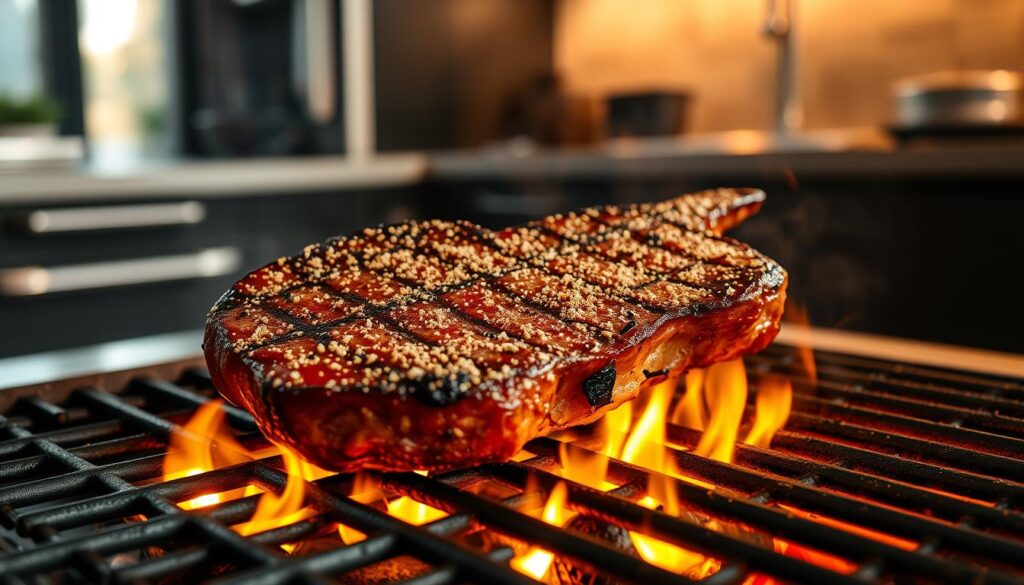
Pan-Searing: Achieving a Perfect Crust
Pan-searing is great for hanger steak, creating a tasty crust. Preheat your skillet well and use oil with a high smoke point, like avocado oil.
To pan-sear, heat the skillet until it’s almost smoking. Add a bit of oil and sear the steak for a few minutes on each side. Then, cook it to your desired doneness.
“A good sear on a steak can make all the difference in the flavor and texture. It’s all about creating a crust that’s caramelized and rich.” – Chef,
Sous Vide: A Modern Approach to Cooking
Sous vide cooking is precise, cooking hanger steak to the exact doneness you want. You seal the steak in a bag and cook it in a water bath at a set temperature.
With sous vide, you can set the temperature for different doneness levels. For example, 130°F to 135°F is perfect for medium-rare. After cooking, a quick sear in a hot skillet adds a nice crust.
- Preheat the water bath to the desired temperature.
- Season the steak before sealing it in a bag.
- Cook for 1-3 hours, depending on the thickness and desired doneness.
- Finish with a quick sear in a hot skillet.
Cooking Times and Temperatures
Cooking hanger steak to the right doneness is more than just a guess. It needs precision in cooking times and temperatures. Getting it just right is key to enjoying the steak’s full flavor and tenderness.
Recommended Doneness Levels
The doneness of hanger steak is based on its internal temperature. Here are the temperatures for different doneness levels:
- Rare: 125-130°F – The steak will be red and juicy, with a warm red center.
- Medium-Rare: 130-135°F – The steak will have a hint of red in the center and will be warm throughout.
- Medium: 135-145°F – The steak will be slightly pink in the center and cooked through.
- Medium-Well: 145-155°F – The steak will have a slight hint of pink and will be mostly cooked through.
- Well-Done: 155°F+ – The steak will be fully cooked with no pink color remaining.
Cooking hanger steak too long can make it tough. Most chefs say to cook it to medium doneness to keep it tender.
Using a Meat Thermometer: Tips and Tricks
Carryover cooking is when the steak’s internal temperature rises after it’s off the heat. To avoid this, remove the steak 5-10°F before your desired doneness.
A meat thermometer is the best way to check your steak’s doneness. Here are some tips for using one:
- Insert the thermometer into the thickest part of the steak, avoiding any fat or bone.
- Make sure the thermometer is calibrated correctly to avoid wrong readings.
- Wait a few seconds for the temperature to stabilize before reading it.
Sides to Pair with Hanger Steak
Adding the right sides to your hanger steak can make a meal special. Hanger steak’s strong flavor is great for many sides, from veggies to starches.
Flavorful Vegetables that Complement
Vegetables add flavor and color to your dish. Roasted asparagus is a good choice because it’s tender and slightly bitter. It balances the steak’s richness. Season it with lemon zest and garlic for extra taste.
Grilled mushrooms, like portobello or shiitake, match the steak’s earthy flavor. A marinade of olive oil, thyme, and balsamic vinegar boosts their flavor.
Caramelized Brussels sprouts are sweet and savory. Cut them in half and cook at high heat with olive oil and salt for perfect caramelization.
Best Starches for a Hearty Meal
Starches make your hanger steak meal hearty. Truffle mashed potatoes are luxurious, mixing earthy truffle flavor with creamy potatoes. For a rustic touch, try roasted fingerling potatoes with rosemary and garlic.
Polenta or farro offer a nice texture contrast. Polenta’s creaminess goes well with the steak, while farro’s nutty taste complements the steak’s richness.
Pairing starches with hanger steak needs careful timing. If grilling the steak, quickly sauté spinach or roast vegetables in the remaining time.
For a balanced plate, mix colors and textures. A well-rounded meal is pleasing to both the taste and sight. Make-ahead items like roasted veggies or cooked starches make cooking easier, letting you focus on the steak.
How to Serve Hanger Steak
Serving hanger steak is an art that needs attention to detail. The way you present and slice your steak can make the experience better. It makes your guests’ meal more enjoyable and memorable.
Presentation Tips for Impressing Guests
To impress your guests, focus on how you present your hanger steak. Chefs use plating strategies like the fan method and stacked arrangement. These showcase the steak’s crust and color.
Garnishing is key. Use herb sprigs, finishing salts, and compound butter to add flavor and look. The choice of plate and its temperature also matters.
Slicing Techniques for Maximum Tenderness
Slicing your hanger steak right is important for tenderness. Always slice against the grain. This means cutting the meat across the muscle lines. It’s a bit tricky with hanger steak, but it’s essential.
Slices should be ¼ to ½ inch thick. This keeps the steak juicy and easy to chew. Letting the steak rest for 7-10 minutes before slicing is also key. It makes the steak more flavorful and tender.
| Slicing Technique | Description | Benefits |
|---|---|---|
| Against the Grain | Slicing perpendicular to the muscle fibers | Maximum tenderness, easier to chew |
| With the Grain | Slicing parallel to the muscle fibers | Less tender, may be chewy |
| Resting | Letting the steak rest before slicing | Juices redistribute, more flavorful |
By using the right slicing techniques and presentation, you can make a great hanger steak even better. It becomes a memorable dining experience.
Sauces and Seasonings for Hanger Steak
Hanger steak’s strong flavor is perfect for many sauces and seasonings. These can make your meal even better. They add a special touch that makes your dining experience unforgettable.
Classic Sauces to Enhance Your Steak
Classic sauces bring a rich flavor to your hanger steak. A red wine reduction sauce is great, made with reduced red wine, shallots, and stock. It adds a bold, fruity taste.
Béarnaise sauce is another excellent choice. It’s creamy and slightly tangy. For a fresh, herby taste, try chimichurri sauce. It’s made with parsley, oregano, garlic, and vinegar.
Make these sauces ahead of time to let the flavors mix well. It’s important to serve them at the right temperature. Béarnaise should be warm but not hot to avoid breaking.
- Red wine reduction
- Béarnaise sauce
- Chimichurri sauce
Unique Seasoning Blends to Try
For new flavors, try unique seasoning blends. A Montreal steak seasoning blend adds a savory, spicy taste. Or, try Ras el Hanout, a North African spice blend, for a complex, aromatic flavor.
When using dry seasonings, know when to apply them. Some are best before cooking to create a crust. Others are used just before serving. Knowing about fat-soluble and water-soluble flavors helps you choose the right seasoning at the right time.
| Seasoning Blend | Flavor Profile | Application Time |
|---|---|---|
| Montreal Steak Seasoning | Savory, slightly spicy | Before cooking |
| Ras el Hanout | Complex, aromatic | Before or after cooking |
Common Mistakes to Avoid
Even experienced cooks can make mistakes when cooking hanger steak. Knowing these common errors can help you avoid them. Cooking a great hanger steak needs attention to detail and knowledge of common pitfalls.
Overcooking: The Consequences
Overcooking hanger steak makes it tough and dry. It’s best cooked to medium-rare or medium. If you cook it too long, the meat becomes less tasty.
Temperature Monitoring Strategies
To prevent overcooking, check the steak’s internal temperature. A meat thermometer is key. For medium-rare, aim for 130°F – 135°F (54°C – 57°C). For medium, it should be 140°F – 145°F (60°C – 63°C).
| Doneness Level | Internal Temperature (°F) | Internal Temperature (°C) |
|---|---|---|
| Medium-Rare | 130 – 135 | 54 – 57 |
| Medium | 140 – 145 | 60 – 63 |
The Importance of Resting
Not resting the steak is a common mistake. Resting makes the steak tender and flavorful. It allows the meat to relax and reabsorb juices.
Proper Resting Techniques
To rest a hanger steak, take it off the heat and let it sit for 5-10 minutes. Use foil to keep it warm, but don’t wrap it too tight. This can steam the steak instead of keeping it warm.
Leftover Hanger Steak Ideas
Transform yesterday’s hanger steak into today’s masterpiece with a few creative ideas. This is great for saving time or reducing waste. There are many ways to reuse leftover hanger steak.
Creative Recipes for Leftover Steak
Leftover hanger steak can become many dishes. Try steak sandwiches with caramelized onions and special sauce. The onions’ sweetness matches the steak’s savory taste.
For an Asian twist, make a steak salad with soy sauce, ginger, and honey dressing. Leftover steak also works well in breakfast dishes like steak and eggs with hollandaise sauce. This adds a rich flavor to your morning.
For a quick meal, steak tacos with avocado, salsa, and sour cream are perfect. They’re easy and delicious.
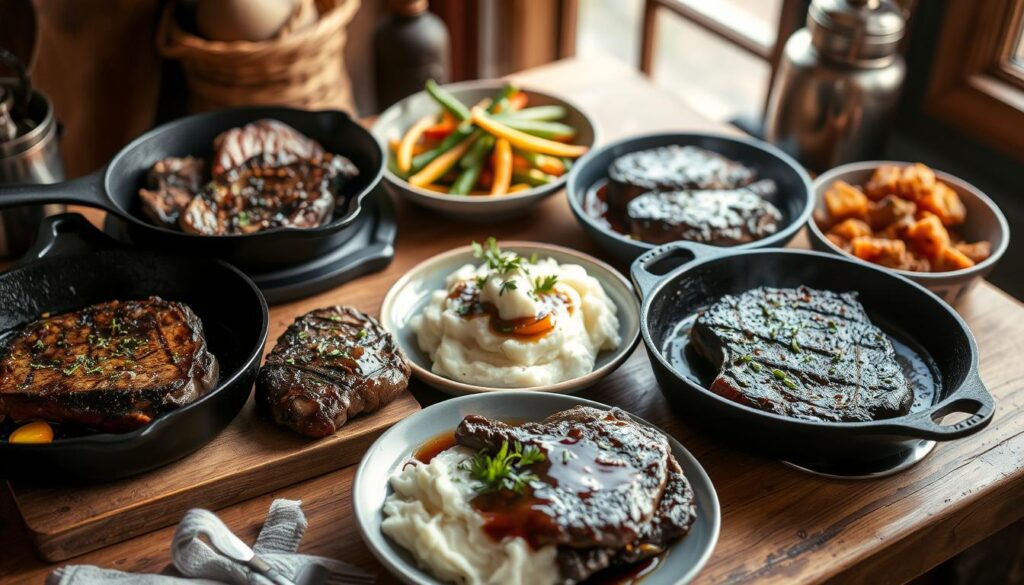
Meal Prep Tips for Busy Cooks
For meal prep, cooking extra hanger steak is smart. Cook leftovers slightly under, so they stay tender when reheated.
Reheating steak can be done in several ways. Sous vide is best for keeping it moist and tender. Quick searing also works well to restore the steak’s texture.
Reheating Methods Comparison
| Reheating Method | Effectiveness | Retention of Moisture |
|---|---|---|
| Sous Vide | High | Excellent |
| Pan Searing | Medium | Good |
| Oven Reheating | Low | Fair |
Using leftover steak in cold dishes is another great idea. Salads and chilled appetizers are perfect for avoiding reheating. They offer a fresh twist on steak dishes.
To keep leftover steak fresh, cool it quickly and store it in airtight containers. Use it within a few days. This way, you can enjoy your hanger steak over several meals, making the most of your cooking.
Frequently Asked Questions About Hanger Steak
Hanger steak is a culinary delight that can elevate your dining experience. Whether you’re a seasoned chef or a home cook, there are several questions that commonly arise when preparing this cut of meat.
Common Queries and Their Answers
One of the most frequent questions is about substituting hanger steak with other cuts. If hanger steak is not available, you can consider alternatives like skirt steak, flank steak, or flat iron steak. Each of these cuts has its own cooking requirements. For instance, skirt steak and flank steak are typically cooked to medium-rare and sliced against the grain, while flat iron steak can be cooked to a variety of doneness levels due to its tenderness.
Another common query revolves around managing the varying thickness of hanger steak. To address this, it’s essential to adjust your cooking time based on the thickness of the steak. A thicker steak may require a combination of searing and oven finishing to achieve the desired doneness without burning the exterior.
- For thinner cuts, pan-searing is often sufficient.
- For thicker cuts, consider a reverse sear method by first cooking the steak in a low-temperature oven and then searing it in a hot pan.
Expert Tips for Cooking Hanger Steak
Professional chefs often recommend using a reverse sear method for cooking hanger steak, which is best for thicker cuts. This involves cooking the steak in a low-temperature oven until it reaches your desired level of doneness, followed by a quick sear in a hot pan to develop a flavorful crust.
Another expert tip is to use specialized rubs that enhance crust development. A mix of spices, herbs, and sometimes even coffee or cocoa powder can add depth to the steak’s flavor. Apply the rub generously and let the steak sit for a few minutes before cooking to allow the seasonings to penetrate the meat.
When it comes to serving multiple steaks, timing is key. To ensure that all steaks are served at the same time, you can use a strategy where you stagger the cooking start times based on the thickness and desired doneness of each steak.
Lastly, health and safety are important. Always use a meat thermometer to check for the recommended internal temperatures to avoid undercooking or overcooking the steak. For rare, the internal temperature should be at least 130°F – 135°F, while well-done should be 160°F or above.
Conclusion: Enjoying Your Hanger Steak
Now you know how to cook hanger steak like a pro. Enjoy the perfectly cooked steak with its caramelized outside and juicy inside. Try different ways of cooking and seasoning to find what you like best.
Savoring the Experience
Share your delicious hanger steak with friends and family. Host a steak dinner to show off your cooking skills. Pair it with wine or drinks that match its unique taste.
Continuing the Culinary Journey
Keep improving your hanger steak cooking skills. Try new recipes and techniques. Keep track of your progress to get better over time. With practice, you’ll master cooking hanger steak, combining skill and creativity.
FAQ
What is hanger steak, and where does it come from?
How do you cook hanger steak?
What is the best way to cook hanger steak to achieve tenderness?
How do you trim hanger steak?
Can you marinate hanger steak, and if so, how?
What are some common mistakes to avoid when cooking hanger steak?
How do you know when hanger steak is cooked to the right doneness?
What are some good sides to serve with hanger steak?
How can you repurpose leftover hanger steak?
What are some expert tips for cooking hanger steak?
For more cooking tips, stay connected with us. We also recommend the cookbook Skinnytaste Simple: Easy, Healthy Recipes with 7 Ingredients or Fewer
For more Recipes about Steak ?
Did You try our recipe ?
There are no reviews yet. Be the first one to write one.
